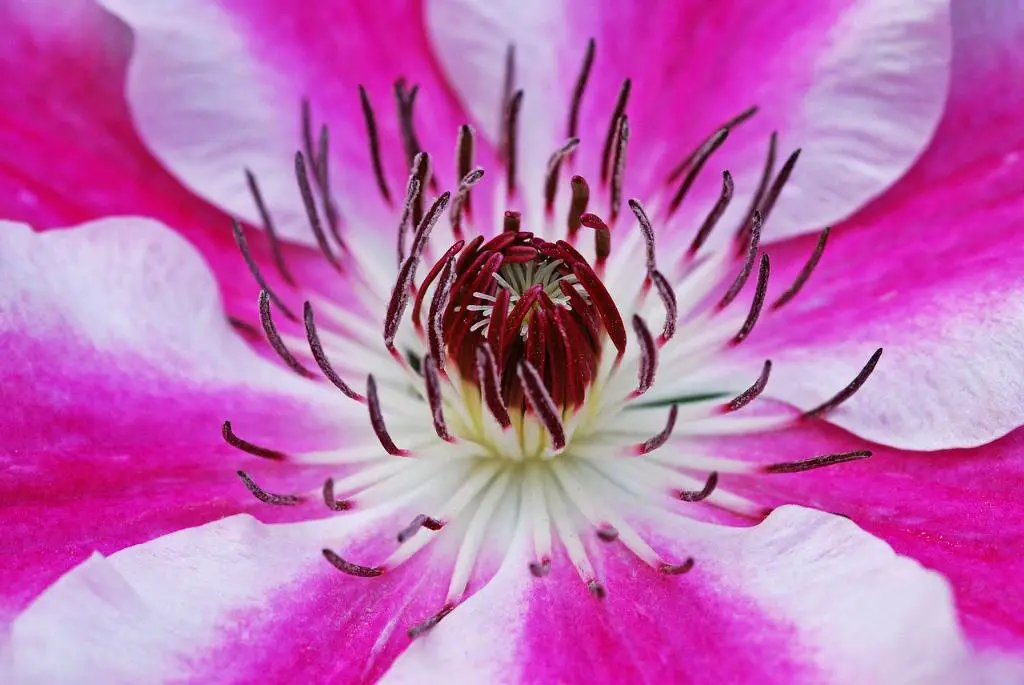If you’ve got a bare fence or trellis that looks like it could use a splash of color, you might want to turn your attention to the clematis flower. This climbing vine is a garden favorite thanks to its beautiful blooms that come in a variety of shapes and hues. Clematis plants can really add a vertical charm to any outdoor space. They’re perennials, so once you get them settled in their favorite spot, you can expect bursts of colors for years to come. With flowers that range from bell-shaped to star-shaped, and colors including purple, pink, red, and blue, there’s a clematis for every garden design.
Popular Varieties of Clematis: Colors and Patterns Galore
Let’s dive into the kaleidoscope of clematis varieties. The ‘Jackmanii’ is probably the most well-known, sporting lush, deep purple blooms. If you prefer something a little lighter, ‘Nelly Moser’ stands out with its pale pink petals and striking dark pink stripes. For gardeners looking to add a touch of drama, the ‘Sweet Autumn Clematis’, which explodes into a mass of small, fragrant white flowers, is a perfect choice. Each variety not only differs in color but in the shape and size of their blooms, offering endless possibilities for enhancing garden aesthetics.
Planting Clematis: Best Practices for a Thriving Vine
Getting clematis off to the right start is crucial. These vines thrive in fertile, well-drained soil with a neutral to slightly alkaline pH level. Planting should be done in early spring or fall when the soil is cool. Here’s a pro tip: clematis roots prefer cool temperatures so it’s beneficial to plant their base in shade while allowing growth to climb up into the sun. Mulching with organic material will help keep the roots moist and cool. So, don’t forget to give these climbers a deep drink and a shady blanket to root under!
Essential Care Tips for Clematis: Watering, Feeding, and Pruning
Clematis needs a bit of TLC to flourish. Regular watering is essential, especially during the hotter months, but beware of water stagnation at the roots. A balanced 10-10-10 fertilizer applied in the spring encourages growth. Pruning varies depending on the type of clematis and is crucial for vibrant blooms. Generally, those that bloom in spring require pruning right after flowering to encourage new growth, whereas those flowering later in the season should be pruned in early spring before new growth begins.
Climbing Support: Ideal Structures for Clematis Growth
These plants are natural climbers and look spectacular when allowed to scale up arbors, trellises, or fences. The key is to provide support that is sturdy but also delicate enough for their tendrils to latch onto. Materials like wire, thin branches, or netting work better than thick bars that might prove too large for clematis tendrils to wrap around. Position your supports at the time of planting to avoid damaging the roots and stems later on.
Pests and Diseases: Keeping Your Clematis Healthy
Watch out for signs of pests and diseases. Clematis can be prone to fungal diseases like clematis wilt, where leaves and stems suddenly blacken and die. It’s also good to keep an eye out for aphids and spider mites. Regular checks and prompt removal of affected parts help prevent spread. Neem oil or insecticidal soaps can be used for treating minor infestations and keeping the vines healthy.
Clematis Through the Seasons: Year-Round Care Guide
Clematis offers year-round interest but requires different care each season. In winter, mulching the base helps protect roots from freezing. Spring is for pruning and feeding, setting the stage for summer blooms. Post-bloom, in autumn, is the time to prepare the plant for the dormancy period. This seasonal cycle when maintained ensures your clematis is robust and blooming each year.
Incorporating Clematis into Your Garden Design
The versatility of clematis makes it superb for various garden styles. You can train them over archways, pergolas, or along fences for a cottage garden look. Alternatively, use them to cover up unsightly walls or boundaries in urban gardens. Their ability to grow upward makes them an excellent choice for smaller spaces, adding height and depth without using much ground area.
Companion Plants for Clematis: Enhancing Garden Harmony
Pairing clematis with suitable companion plants can enhance the health and beauty of your garden ecosystem. Consider planting it alongside roses for a classic combination or with shrubs like hydrangeas that provide the necessary shade for clematis’ roots. Tall sedums or salvia also make great companions, offering a contrast in texture and helping to create a diverse, engaging garden space.

Harvesting and Propagating Clematis: Extend Your Bloom
Last but not least, don’t throw away those pruned clematis cuttings! Spring is the perfect time for propagating new plants. Cuttings taken from healthy stems can be rooted in potting compost to multiply your clematis collection. Not only is this cost-effective, but it’s also a wonderful way to extend the beauty of your favorite vine to other parts of the garden or even share it with fellow gardeners.
